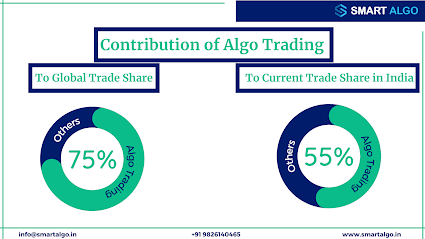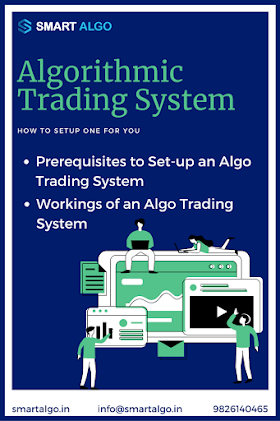The Future of Algo Trading in India and its Evolution Over the Years
The Future of Algo Trading in India and its Evolution Over the Years
You may or may not be familiar with the working of Algo Trading, but if you trade frequently you may have come across the term or something like Automated Trading or Algorithmic Trading and you possibly know what is it (for those unfamiliar with Algo Trading, refer to this blog about Algo Trading and it’s Benefits).
Many People wonder is Algo trading just a phase or is it
an actual serious business? Those who want to incorporate trading through a
comfortable medium must have wondered is it secure enough to start Algo Trading
now. What if the buzz fades? What if the phase passes and you have nothing left
for the future that you invested your money in.
So please be with me this whole time while we go through some facts about the evolution of Algo Trading over the years in India and the very possible future of it.
Well before I tell you what the future is going to be like, first let's just see how the situation was in the past when algo trading started to what it is today to get a better context of future position or expectation. Since, trading is all about numbers and time (mostly), we can see the growth in the past to the present to the future in statistical estimates and get a solid grasp of the situation.
As of 2019, the share of Algo Trading or Algorithmic Trading and High-Frequency Trading in the US and other developed country's market is about 70-75% of their equity market share. While, in India it is becoming more famous with about 49.8% increase in percentage with respect to the total turnover.
When it all Started
On 3rd April
2008, SEBI introduced the Algorithmic Trading to Indian Trading
community and allowed Direct Market Access (DMA) facility to institutional
clients. That meant brokers then provided their clients with access to trading
facilities without intervening from their side. With the facility only provided
to institutional investors in the initial days.
By April 29th
2008, it had already become familiar among global players and they started
switching to DMA facility. In July 2008, many leading brokers started
testing their DMA software to synchronize them to the system at stock
exchanges.
By February
24th 2009, Foreign Institutional Investors (FIIs) were approved to utilize
the DMA facility with Investment managers nominated by them.
And in May 2010,
NSE enabled Financial Information Exchange (FIX) on its trading system and it
boosted transaction speed for foreign investors using DMA.
The Current Position
In India, in the year
2010 the percentage of Algo Trading with respect to the total
turnover was 9.26% (average). By March of 2018, it changed into 44.8% of
the cash market volume and 48.2% of the equity derivatives market
(courtesy NSE data). While 37.22% of the trade on BSE took place through
algo trading.
In March 2018,
around 46.5% of volume of the total trade across the cash and derivatives
market was through Algo Trading that included DMA and co-location. And the
remaining trade was performed through smart order routing, internet and smart
phones and remaining non-algorithmic methods.
According to a National Institute of Financial Management (NIFM) report, around 50% plus of total orders at
both NSE and BSE are algo trades -client side. Prop side algo trades are 40%
plus of total orders placed at both the exchanges. 80% plus orders are
generated from colo at BSE (of total algo orders).
What will be the future?
Some big changes happened in the market along with the rapid
changes in the algorithms and technology in the past. And in the future these
changes in people's approach and innovations in technology are going to be even
more rapid than now. Trading in Future is going to be all about the
calculations and algorithms, the full potential of which is yet to be utilized.
There will be more innovations in the AI arena boosting the
algorithms and making trade placing more logical with analyzing past
performance, current position and news going around and then adapting to what
is the best logical practice.
Industry reports and several estimates suggest that at the global
level, share of algo trading in the markets is going to grow from $11.1
billion in 2019 to $18.8 billion by 2024. The share of
algorithmic trading in the future market is going to grow at a rapid rate till 2026
because cloud-based services for algorithmic trading are going to emerge in the
future.
Calculations could be modified into the chips
straightforwardly for expanded proficiency and simpler correspondence. Global
regulations could come into the foray and make algo trading more globally organized.
According to a survey conducted by Coherent Market Insights,
around 37% of financial institutions in India have invested in algo trading and
artificial intelligence related technologies. And remaining are planning to
join them soon.
With several changes over the years and more to come, India has a vast scope to grow in the arena of algorithmic trading with many factors already contributing to the trend such as colocation facilities and sophisticated technology at both the major exchanges and a smart order routing system.
Thank You for keeping up with me till now. Hope it was
helpful to you.
If you find it informative, do share it with others.
You can visit our website o contact us for more information on Smart Algo - Algo trading software.




Grateful for this algo trading article! Clear, concise, and well-connected to automation trends. Looking forward to more tips on optimizing trading algorithms. Awesome work!
ReplyDeleteI’m really thankful for this well-explained Nifty intraday trading strategyNifty intraday trading strategy. As someone who has struggled with random trades and no clear plan, this approach gave me the structure I needed. It taught me how to spot entry and exit levels with confidence while keeping risk under control.
ReplyDelete